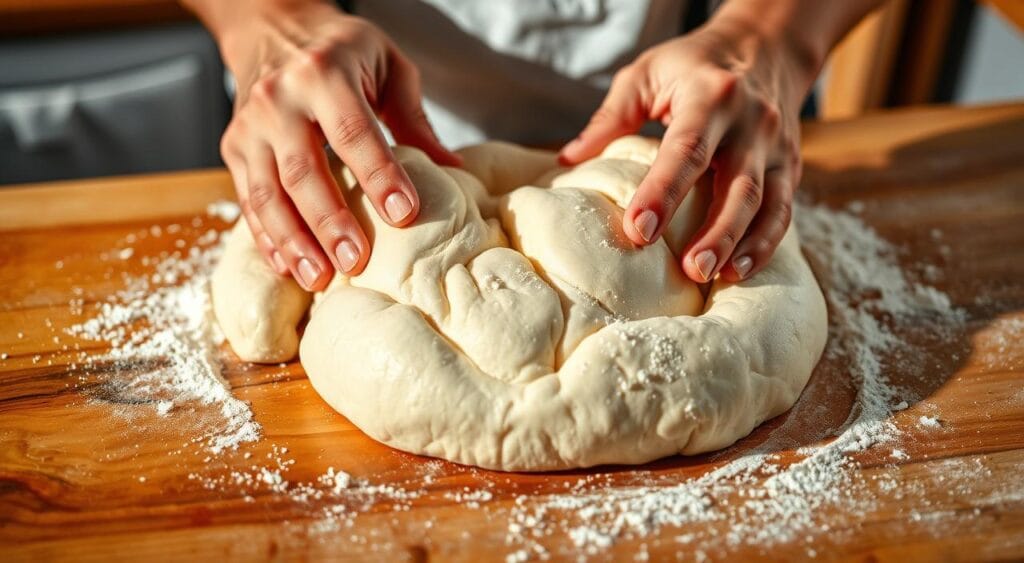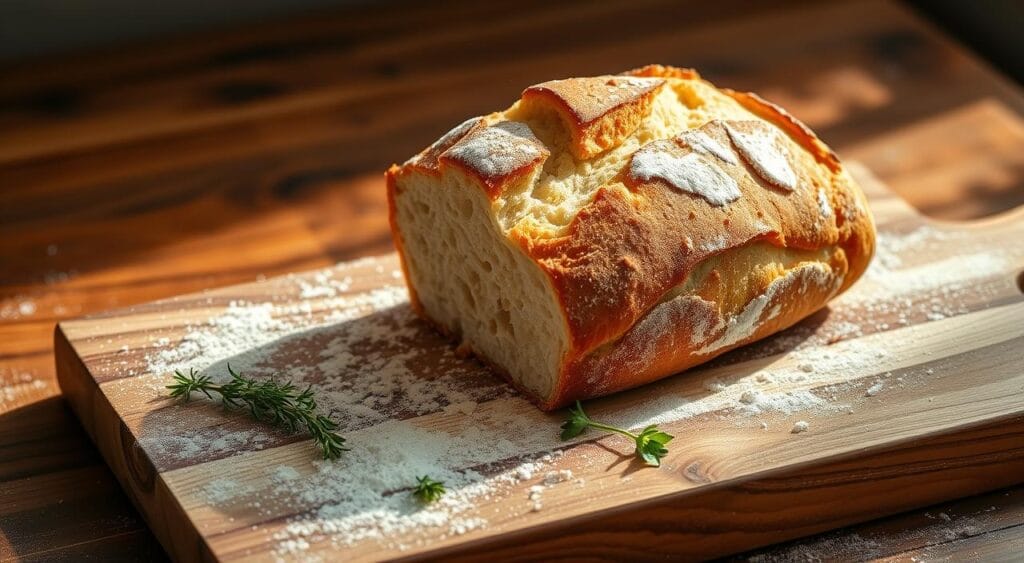Table of Contents
Imagine the smell of fresh bread filling your kitchen. The golden crust shines, and the soft inside invites you to take a bite. This dream is now within reach with your KitchenAid mixer. Let’s start your journey to making perfect homemade bread together.
Baking bread from scratch might seem hard, but our KitchenAid bread recipe makes it easy and fun. This guide is for everyone, from experienced bakers to beginners. You’ll learn how to pick the right ingredients and get that perfect crust. Soon, you’ll be making amazing kitchenaid bread recipe, homemade bread, and baking bread that will wow your family and friends.
Key Takeaways
- Master the art of homemade bread baking with a KitchenAid mixer
- Discover the essential ingredients and techniques for perfect loaves
- Achieve bakery-quality results in your own kitchen
- Impress your loved ones with your homemade bread-making skills
- Enjoy the satisfaction of creating delicious, freshly baked bread from scratch
Introduction to KitchenAid Bread Making
Unlock the power of your KitchenAid mixer and take your bread-making skills to new heights! Crafting homemade bread with a KitchenAid mixer offers a range of benefits. These benefits can elevate your baking experience and deliver consistently delicious results.
Benefits of Using a KitchenAid Mixer
The KitchenAid mixer is a versatile and reliable kitchen companion. It can streamline your bread-making process. With its powerful motor and various attachments, you can effortlessly mix, knead, and prepare your dough.
This saves you valuable time and effort. The mixer’s consistent performance ensures your dough is perfectly kneaded every time. This results in a light and airy texture that’s essential for creating exceptional homemade bread.
Overview of Homemade Bread
Baking your own bread at home allows you to control the ingredients. It also offers numerous nutritional benefits compared to store-bought options. Homemade bread is often made with fewer preservatives and artificial additives.
This makes it a healthier choice for you and your family. The process of kneading and rising the dough can be a rewarding and therapeutic experience. It allows you to create a unique and personal touch to your baked goods.
Unleash your culinary creativity and embark on an exciting kitchenaid mixer bread-making journey. This journey will fill your kitchen with the irresistible aroma of freshly baked loaves. Get ready to impress your loved ones with the delicious and satisfying results of your homemade breadmaking tips.
Essential Ingredients for Your Bread
Baking the perfect homemade bread starts with the right ingredients. From bread flour to yeast, each part is crucial. They determine the bread’s texture, flavor, and structure. Let’s explore why these ingredients are so important.
Flour Types and Their Roles
The base of any bread is flour. Different flours, like all-purpose, whole wheat, or bread flour, bring unique qualities. All-purpose flour gives a balanced texture. Whole wheat adds a nutty flavor and more fiber.
Bread flour, with its high gluten content, makes the bread chewier and more structured.
Importance of Yeast
Yeast is the hero of yeast bread making. It makes the dough rise, creating light and airy texture. Knowing the differences between active dry and instant yeast helps achieve the perfect rise.
Liquid Components: Water and Milk
Water and milk are key in your bread recipe. Water hydrates the dough, while milk adds richness, tenderness, and sweetness. It also helps the crust turn golden.
| Ingredient | Role | Recommended Quantity |
|---|---|---|
| Bread flour | Provides structure and chewiness | 2-3 cups |
| Active dry yeast | Responsible for rise and expansion | 2-2.5 teaspoons |
| Water | Hydrates the dough | 1-1.5 cups |
| Milk | Adds richness, tenderness, and color | 1/4-1/2 cup |
Understanding these ingredients helps you bake delicious homemade bread. It will be tailored to your taste.
“Baking bread is one of the most fulfilling and rewarding experiences in the kitchen. With the right ingredients and techniques, anyone can create a masterpiece.”
Preparing Your KitchenAid Mixer
Baking homemade bread with your KitchenAid mixer is very rewarding. But, you need to make sure your mixer is ready. Let’s look at how to get your KitchenAid ready for bread-making.
Choosing the Right Attachment
The first thing to do is pick the right attachment. For bread, you need the KitchenAid dough hook. It kneads the dough well, making your loaves smooth and perfect.
Setting Up Your Workspace
Now, pick the right spot for your mixer. Clear a big area on your countertop or table. This space is for your mixer and any other things you’ll need.
Having a tidy workspace helps a lot. Keep flour, yeast, and measuring cups close. This makes mixing and kneading easier.
By getting your KitchenAid ready and setting up your space, you’re on your way. You’ll make delicious bread machine recipes that everyone will love.
Step-by-Step Instructions for Dough Preparation
Learning to make homemade bread dough is key to baking tasty loaves and rolls with your KitchenAid mixer. We’ll go through each step to make sure your bread dough is perfect every time.
Mixing Dry Ingredients
Start by accurately measuring the dry ingredients. In your KitchenAid mixer bowl, mix together the bread dough flour, yeast, salt, and any extra dry seasonings or herbs. Use the paddle attachment on low speed to mix them well.
Adding Wet Ingredients
Now, add the wet ingredients. Pour in the warm water, milk (or plant-based milk), and any other liquids like honey or oil into the mixer bowl. Start on low speed and then move to medium. This helps the ingredients blend into a shaggy dough.
Kneading the Dough
After the dough forms, switch to the dough hook attachment. Knead on medium speed for 5-7 minutes. This step is crucial for developing the gluten, making the dough soft and pliable. Watch the dough’s texture and add flour or water as needed.
By following these steps, you’re on your way to making delicious homemade bread with your KitchenAid mixer. Enjoy the journey of creating your own KitchenAid bread from scratch.
“Baking bread is one of the most meditative and satisfying things you can do. The process is calming, yet the result is empowering – you have literally created sustenance from a few simple ingredients.”
First Rise: Letting Your Dough Expand
The first rise is key in making bread. It lets the bread dough get its flavor and texture. Yeast in the dough ferments, making it light and airy.
Ideal Temperature and Environment
To make a great first rise, you need the right environment. The dough should be between 70°F and 85°F. This helps the yeast work well, making the dough rise evenly.
Stay away from drafts and sunlight. They can make the dough rise too fast or unevenly. Instead, use a warm, draft-free spot like the oven with the light on.
Timing Your First Rise
The first rise time varies. It depends on the recipe, kitchen temperature, and yeast type. Generally, it takes 1 to 2 hours for the dough to double in size.
Watch the dough closely. Adjust the time if it’s rising too fast or slow. When it’s soft, puffy, and shiny, it’s ready. Gently punch it down to release air before moving on.
Shaping Your Dough for Baking
Learning to shape your homemade bread dough can really improve your baked loaves. Whether you’re making classic sandwich bread or aiming for artisanal perfection, the right techniques matter. Here are some methods to turn your bread dough into beautiful and tasty creations.
Techniques for Shaping Loaves
Shaping your bread dough into classic loaves is key for any home baker. First, gently deflate the dough to get rid of air bubbles. Then, shape it into a rectangle or oval, matching your baking pan’s shape. Roll the dough from the short end to make a tight cylinder.
Pinch the seam to seal it, and put the dough in your pan, seam-side down.
Tips for Creating Artisan Shapes
For a rustic, artisanal look, try free-form loaves. Start by stretching and folding the dough to create layers and air pockets. Then, shape it into an oval or round, tucking the edges under for a smooth surface.
You can also divide the dough into smaller pieces for rolls or buns. The possibilities are endless with artisan bread shaping!
Remember to handle the dough gently to keep its structure. With practice, you’ll make beautiful, bakery-quality loaves at home. Try different shaping techniques to find your unique style. Check out the versatility of your bread dough and experiment with new ways to shape it.

Second Rise: The Final Touch
The first rise is key for gluten and flavor. But the second rise is just as important for the perfect texture. It lets the yeast create air pockets, making the bread light and fluffy.
Importance of the Second Rise
The second rise has several important roles:
- It makes the bread softer and more tender.
- It helps the dough rise more, making loaves bigger.
- It enhances flavor by giving yeast more time to work.
How to Know When It’s Ready
Knowing when the second rise is done is crucial. Look for these signs:
- The dough should have doubled in size and feel soft.
- When you press it gently, the dent should fill back in slowly.
- The dough should smell yeasty, showing fermentation is happening.
The second rise time can change based on temperature and recipe. Watch your dough closely and adjust the time as needed. With practice, you’ll make bread dough that’s light, airy, and delicious.
Baking Your Bread to Perfection
Baking homemade bread is an art. Getting the oven temperature and baking times right is key. Whether it’s a classic baking bread or trying new flavors, mastering baking is essential.
Preheating Your Oven
Before baking, make sure your oven is preheated. For most bread, the ideal temperature is between 350°F and 450°F. This depends on the bread type and the crust you want.
Baking Times and Temperatures
The baking time varies with loaf size and oven temperature. Here are some general guidelines:
- Sandwich bread: 350°F for 30-40 minutes
- Artisan-style loaf: 425°F for 20-30 minutes
- Rolls or buns: 400°F for 15-20 minutes
Watch your bread closely while it bakes. Use a thermometer to check the internal temperature. Aim for 195°F to 205°F for a perfect crust and soft inside.
“The smell of freshly baked bread is one of the most comforting and inviting aromas in the world.”
By following these tips and experimenting, you’ll make delicious homemade bread every time.
Cooling and Storing Your Bread
After baking your homemade bread, the last step is keeping it fresh. Cooling and storing it right is key to enjoying it for days.
Why Cooling is Crucial
Let your freshly baked homemade bread cool completely. This helps the inside set and the crust stay crisp. Waiting for it to cool fully will give you a better texture.
Best Practices for Storing Bread
After cooling, think about how to store your bread. Keeping it away from air is important to prevent drying. Here are some tips:
- Store it in a bread box or paper bag, not plastic bags. Plastic can trap moisture and cause mold.
- If you’ll eat it in a few days, keep it on the counter. For longer, freeze it to keep it fresh longer.
- Only slice the bread when you’re ready to eat it. Sliced bread dries out faster.
By following these breadmaking tips, you’ll enjoy your homemade bread for days. You’ll impress everyone with your baking skills!

Troubleshooting Common Bread Problems
Baking bread at home can be rewarding but comes with challenges. As you start your KitchenAid bread-making journey, you might face some common issues. Don’t worry, with a bit of troubleshooting, you can solve these problems and make perfect homemade loaves every time.
Dough Too Sticky or Dry?
The dough’s consistency is key for the right texture. If it’s too sticky, it’s hard to work with and might not shape right. If it’s too dry, it can be tough and crumbly. Here’s how to fix these problems:
- For sticky dough, add a little extra flour, a tablespoon at a time, until it’s easier to handle.
- If the dough is too dry, add a bit more water or milk, a tablespoon at a time, until it’s right.
Bread Not Rising?
A common issue is when bread doesn’t rise, leading to dense loaves. There are a few reasons for this:
- Ensure your yeast is fresh and active. Old or inactive yeast won’t help the dough rise.
- Check the proofing area. Bread needs a warm, draft-free spot to rise well. If it’s too cold, the yeast won’t work right.
- Avoid over-kneading the dough. This can damage the gluten and stop the dough from rising.
By fixing these common problems, you’ll be on your way to baking perfect, homemade bread dough and yeast bread every time.
Variations to Try with Your KitchenAid Bread Recipe
Make your kitchenaid bread recipe and homemade bread even better by trying new flavors. Whether you’re an expert baker or just starting, adding herbs, spices, whole grains, and seeds can elevate your bread. It’s a great way to make your loaves more delicious.
Adding Herbs and Spices
Herbs and spices can add a lot of flavor to your bread. Try using rosemary, thyme, garlic, cinnamon, or cumin for unique tastes. Mix them well into the dough to spread the flavors evenly.
Incorporating Whole Grains or Seeds
Adding whole grains or seeds can make your kitchenaid bread recipe healthier and more interesting. Use whole wheat flour, oats, quinoa, or sunflower or flax seeds instead of some all-purpose flour. Find the right mix of flavors and textures that you enjoy.
| Ingredient | Suggested Quantity | Impact on Bread |
|---|---|---|
| Rosemary | 1-2 tablespoons, chopped | Earthy, fragrant flavor |
| Whole Wheat Flour | Up to 50% of total flour | Increased fiber and nutty taste |
| Sunflower Seeds | 1/4 to 1/2 cup | Crunchy texture and nutty notes |
When trying new things, start with a little and adjust as needed. Enjoy the process of finding new flavors and textures. Let your creativity show in every loaf you bake.
“Baking bread is one of the most rewarding and satisfying experiences in the kitchen. With a little experimentation, you can create truly unique and flavorful loaves that will impress your family and friends.”
Final Thoughts on Your KitchenAid Bread Journey
Baking homemade bread with your KitchenAid mixer is rewarding. It’s a great experience for both new and experienced bakers. You now know how to make delicious, artisanal loaves that will wow everyone.
Remember, the more you bake, the better you’ll get. You’ll become more confident and skilled.
Encouragement for Future Baking
Don’t be afraid to try new recipes. Baking bread is like art, and every loaf is a unique creation. Keep baking, and you’ll find your own style.
You’ll make KitchenAid bread recipes that are just right for you.
How to Experiment with Flavors and Textures
Your KitchenAid mixer lets you try many flavors and textures. Use different flours like whole wheat or rye for heartier loaves. Try adding herbs, spices, or dried fruits and nuts for unique twists.
Remember, the most important thing is to have fun. Enjoy the journey of finding new bread recipes.
FAQ
What are the benefits of using a KitchenAid mixer for bread making?
A KitchenAid mixer saves time and ensures consistent results. It makes kneading dough easy. The powerful motor and attachments make bread making efficient and straightforward.
What are the essential ingredients for homemade bread?
Homemade bread needs flour, yeast, water, and sometimes milk or other liquids. Knowing each ingredient’s role is key for the perfect texture and flavor.
How do I properly set up my KitchenAid mixer for bread making?
To set up your KitchenAid mixer, choose the right attachment, like the dough hook. Organize your workspace for efficient baking. This ensures a smooth bread-making process.
What are the key steps in preparing the bread dough using a KitchenAid mixer?
Preparing bread dough involves mixing dry ingredients, adding wet ingredients, and kneading. Follow a step-by-step guide to achieve the perfect dough for your homemade bread.
How important is the first rise in the bread-making process?
The first rise, or proofing, is crucial. It allows the dough to expand and develop flavor. Understanding the ideal temperature and timing is essential for successful homemade bread.
How do I shape my bread dough for baking?
Shaping your dough impacts your bread’s appearance and texture. Mastering techniques like classic loaves or artisanal shapes will help you achieve the desired result.
What is the importance of the second rise in bread making?
The second rise, or proofing, is the final stage before baking. It’s crucial for the bread’s texture and structure. Knowing when your dough is perfectly proofed is key to a successful bake.
How do I bake my bread to perfection?
Baking your bread to perfection requires understanding oven temperatures and baking times. Proper preheating and monitoring the baking process will result in a golden crust and soft interior.
How should I cool and store my homemade bread?
Cooling your bread properly and storing it correctly are essential. Understanding the importance of cooling and learning effective storage methods will help you enjoy your homemade bread at its best.
How can I troubleshoot common bread-making problems?
If you encounter sticky or dry dough, or your bread isn’t rising, there are solutions. Practical advice and expert tips can help you troubleshoot and overcome these common problems.
What variations can I try with my KitchenAid bread recipe?
Try adding herbs, spices, whole grains, or seeds to your basic KitchenAid bread recipe. Exploring creative variations can help you develop your own signature bread recipes.

